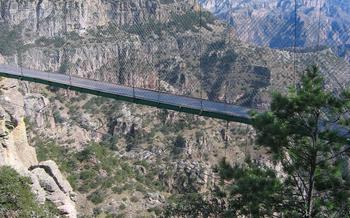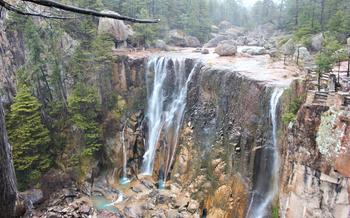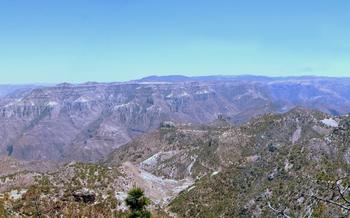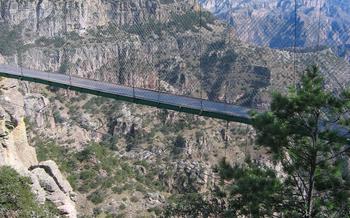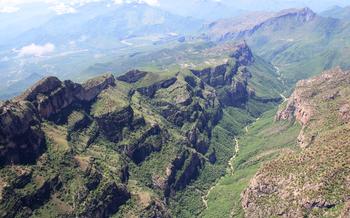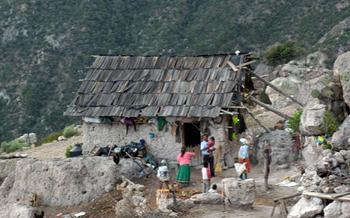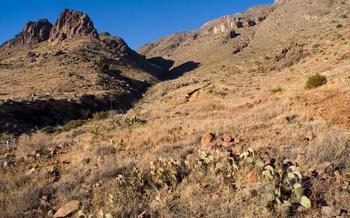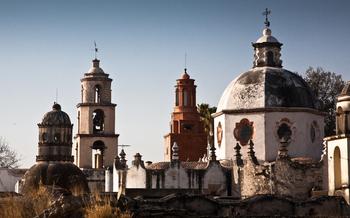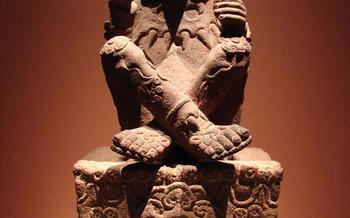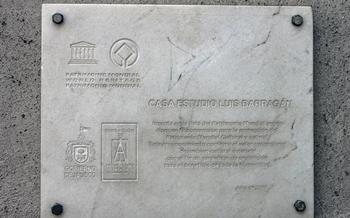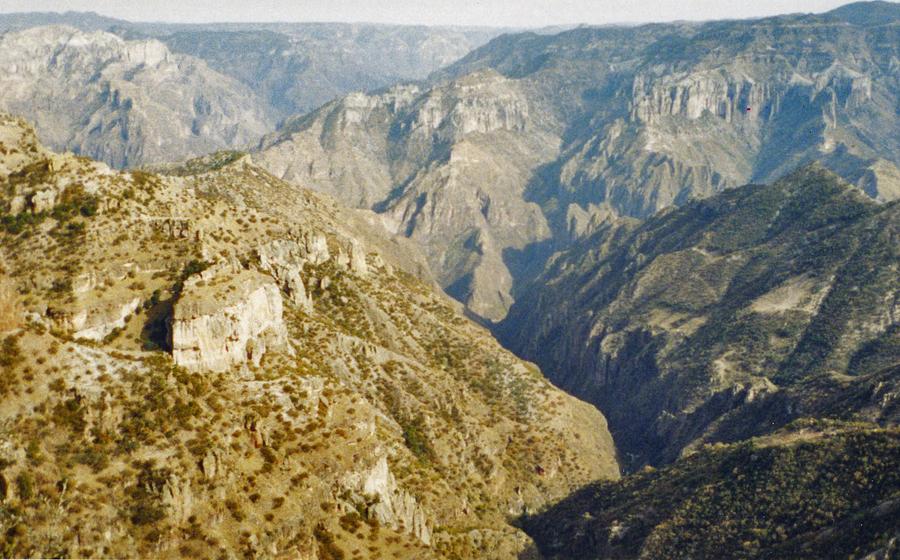
Paquimé Ruins
- Explore the Enigmatic Ruins of Paquimé, a UNESCO World Heritage Site
- Location and Accessibility
- What to See and Do
- Best Time to Visit
- What to Wear and Bring
- Guided Tours
- Self-Guided Exploration
- Accommodation and Dining
- Cultural Significance
- Photography Tips
- Accessibility for Visitors with Disabilities
- Family-Friendly Activities:
- Local Customs and Etiquette
- Sustainable Tourism
- Insider Tip: Uncover Hidden Gems and Explore Beyond Paquimé
Explore the Enigmatic Ruins of Paquimé, a UNESCO World Heritage Site
Journey back in time to the ancient city of Paquimé, a UNESCO World Heritage Site nestled within the rugged landscapes of Mexico's Copper Canyon. Uncover the secrets of the Paquimé culture, the largest pre-Columbian settlement in northern Mexico. Marvel at the architectural prowess of the Paquimé people as you explore the well-preserved ruins, including the Great House, ball courts, and residential compounds. Decipher the intricate petroglyphs and rock art that adorn the site, providing glimpses into the lives and beliefs of this enigmatic civilization. Discover the significance of Paquimé's role in trade and cultural exchange, serving as a vital hub connecting diverse cultures of the region. Embark on a journey through history and immerse yourself in the captivating legacy of the Paquimé people.
Location and Accessibility
The Paquimé ruins are situated in the heart of the Copper Canyon region, a stunning expanse of canyons, valleys, and rivers in northwestern Mexico. To reach Paquimé, you can embark on a scenic journey from the city of Chihuahua, approximately 350 kilometers away, or El Paso, Texas, across the US-Mexico border. The drive from Chihuahua takes about 6 hours, traversing through picturesque landscapes and small towns. From El Paso, the journey is slightly longer, taking around 7-8 hours.
Once you arrive in the Copper Canyon region, the town of Casas Grandes serves as a convenient base for exploring Paquimé. From Casas Grandes, you can book guided tours that typically depart in the morning and return in the evening. If you prefer a self-guided experience, you can rent a car and drive to the ruins independently. The road leading to Paquimé is mostly paved, but it's advisable to have a vehicle with good ground clearance, as some sections may be rough.
What to See and Do
Immerse yourself in the captivating world of Paquimé and discover the remarkable legacy of the Paquimé culture. Explore the meticulously preserved ruins, including the awe-inspiring Great House, a testament to the architectural prowess of this ancient civilization. Marvel at the intricate petroglyphs and rock art that adorn the site, offering a glimpse into the beliefs and traditions of the Paquimé people. Engage with interactive exhibits and displays that bring the Paquimé culture to life, shedding light on their way of life, social structure, and economic activities. Delve deeper into the history of this remarkable civilization and uncover the secrets that lie within the ruins of Paquimé.
Beyond the ruins, immerse yourself in the breathtaking natural beauty of the surrounding Copper Canyon landscape. Embark on scenic hikes or mountain biking trails, taking in the panoramic vistas and diverse ecosystems that define this region. Discover hidden waterfalls, lush forests, and towering canyons, each offering a unique perspective on the natural wonders of the Copper Canyon. Whether you're a history buff, nature enthusiast, or simply seeking an unforgettable adventure, Paquimé and the Copper Canyon offer a wealth of experiences that will leave you captivated and inspired.
Best Time to Visit
Timing is crucial when planning a visit to Paquimé. The ideal period to experience the site's wonders is during the spring (March to May) and fall (September to November) seasons. During these months, the weather is generally mild and pleasant, with moderate temperatures ranging from 15°C to 25°C. The skies are often clear, providing excellent visibility for capturing stunning photographs of the ruins.
In contrast, the summer months (June to August) should be avoided due to extreme heat and limited accessibility. Temperatures can soar above 35°C, making it uncomfortable to explore the exposed ruins under the scorching sun. Additionally, heavy rainfall during the summer can make the roads leading to Paquimé impassable, hindering your journey.
While Paquimé is open year-round, it's worth noting that some facilities and services may be limited during the off-season (December to February). However, if you're seeking a more secluded and intimate experience, this period can offer fewer crowds and a unique opportunity to connect with the site's tranquility.
Remember to plan your visit in advance, especially if you intend to travel during peak tourist season (November to April). This will ensure you secure accommodations, guided tours, and transportation without any last-minute surprises.
What to Wear and Bring
When packing for your visit to Paquimé, it is crucial to consider the desert climate and the nature of your exploration. Lightweight, breathable clothing is essential to combat the heat, and comfortable shoes with good traction are necessary for navigating the uneven terrain of the ruins. Sun protection is paramount, so don't forget your sunscreen, sunglasses, and a wide-brimmed hat.
Staying hydrated is key, so bring a reusable water bottle and replenish it regularly. Snacks are also advisable, as food options are limited on-site. Remember, the desert sun can be unforgiving, so plan your visit accordingly and take breaks in shaded areas to avoid heat exhaustion.
Guided Tours
Booking a guided tour offers several advantages for exploring Paquimé. Knowledgeable guides provide historical insights and context, enhancing your understanding of the site's significance. Various tour options are available, ranging from full-day trips to multi-day itineraries that delve deeper into the region's history and culture.
To ensure your spot, especially during peak season, reservations should be made in advance. Join a guided tour to uncover the secrets of Paquimé and gain a deeper appreciation for the ancient civilization that once thrived here.
Self-Guided Exploration
If you prefer a more independent and flexible experience, self-guided exploration of Paquimé is possible. To make the most of your visit, consider the following tips:
-
Research and Preparation: Before your trip, conduct thorough research on the history and significance of Paquimé. Read guidebooks, articles, or online resources to gain a deeper understanding of the site.
-
Purchase a Guidebook: Invest in a comprehensive guidebook that provides detailed maps, descriptions of the ruins, and historical context. This will help you navigate the site and make informed observations.
-
Plan Your Visit: Determine the duration of your visit and plan your route accordingly. Allocate sufficient time to explore the various sections of the ruins and appreciate the intricate details.
-
Wear Comfortable Shoes: The terrain at Paquimé can be uneven and rocky, so wear comfortable and sturdy shoes suitable for walking on uneven surfaces.
-
Bring Water and Snacks: As there are limited facilities available on-site, bring a sufficient supply of water and snacks to stay hydrated and energized throughout your exploration.
-
Arrive Early: Plan to arrive at Paquimé early in the morning to avoid the midday heat and crowds. This will allow you to explore the ruins at a leisurely pace and capture the best light for photography.
-
Be Mindful of the Environment: Respect the fragile nature of the ruins and the surrounding environment. Avoid touching or climbing on the structures, and dispose of waste responsibly.
-
Enjoy the Experience: Self-guided exploration offers the freedom to set your own pace and focus on the aspects of Paquimé that interest you most. Take your time, observe the details, and immerse yourself in the history and beauty of this ancient site.
Accommodation and Dining
While there are limited accommodation options near Paquimé, planning is essential to ensure a comfortable stay. Consider lodging in nearby towns like Casas Grandes or Chihuahua for a broader range of hotels and guesthouses. Remember to book in advance, especially during the peak tourist season, to avoid any last-minute surprises.
Dining options are also limited in the immediate vicinity of Paquimé. Packing snacks or planning meals at local restaurants in nearby towns is recommended. Check for availability and make reservations beforehand, particularly during the high season, to avoid disappointment. Embracing the local cuisine is a fantastic way to enhance your cultural experience.
Cultural Significance
Paquimé stands as a testament to the rich cultural heritage of Mexico and the enduring legacy of indigenous civilizations. Its ruins offer a glimpse into the sophisticated society that once thrived in the heart of the Copper Canyon. Explore the site and learn about the intricate social, political, and economic systems that governed the Paquimé culture. Discover the significance of their trade networks, which extended far beyond the borders of their territory, and appreciate the lasting contributions they made to Mesoamerican civilization.
As you wander through the ruins, reflect on the efforts undertaken to preserve and protect this important site. Paquimé has been designated a UNESCO World Heritage Site, recognizing its outstanding universal value. Ongoing archaeological research and conservation projects aim to safeguard the integrity of the ruins and ensure their preservation for future generations.
Immerse yourself in the cultural identity of the region, which is deeply intertwined with the legacy of the Paquimé people. Visit local museums and cultural centers to gain a deeper understanding of their traditions, beliefs, and way of life. Attend traditional festivals and events that celebrate the rich cultural heritage of the Copper Canyon and its indigenous communities.
Photography Tips
Capture the essence of Paquimé's ancient ruins and the surrounding landscape through stunning photographs. Utilize a wide-angle lens to encompass the grandeur of the site, allowing you to capture both the intricate details and the sweeping vistas. Experiment with various angles and perspectives to create unique and captivating shots. Take advantage of the golden hours of sunrise and sunset, when the soft, warm light casts a magical glow upon the ruins, creating dramatic and unforgettable images. Embrace the opportunity to document your journey through Paquimé, preserving the memories of your exploration for years to come.
Accessibility for Visitors with Disabilities
Traveling to Paquimé is a remarkable experience for all, including visitors with disabilities. The site strives to be accessible and inclusive, ensuring that everyone can enjoy the wonders of this ancient city. Upon arrival, inquire about wheelchair accessibility and any special assistance available. Although certain areas may be challenging to navigate due to uneven terrain and historical preservation, the site offers alternative ways to experience Paquimé's rich history and culture. Guided tours often provide detailed descriptions and explanations, allowing visitors to immerse themselves in the site's significance without compromising their comfort. Additionally, explore the informative exhibits and displays at the visitor center, which offer a comprehensive overview of Paquimé's past and its enduring legacy.
Family-Friendly Activities:
Traveling to Paquimé with children can be a rewarding experience. To make the most of your visit, consider these tips:
-
Interactive Activities: Look for interactive activities and educational programs offered on-site. Many museums and cultural centers have hands-on exhibits, guided tours designed for children, and workshops where kids can learn about history and culture through play.
-
Exploration and Discovery: Encourage children to explore the ruins and discover their history. Provide them with age-appropriate information about the Paquimé culture and its significance. Let them explore the ruins at their own pace, allowing them to make their own discoveries.
-
Breaks and Fun: Plan breaks and incorporate fun activities to keep kids entertained throughout the visit. Pack snacks and drinks, and find shady spots to rest and recharge. Consider bringing along games or activities that can be enjoyed outdoors, such as frisbees or balls.
-
Local Experiences: Involve children in local experiences to deepen their understanding of the culture. Visit local markets, try traditional foods, and interact with the friendly people of the region. These experiences will create lasting memories for your family.
Local Customs and Etiquette
When visiting Paquimé, it is essential to respect local customs and traditions to ensure a harmonious and enjoyable experience for all. Here are some guidelines to keep in mind:
-
Dress modestly: Avoid wearing revealing clothing that may be considered disrespectful in the local culture. Opt for conservative attire that covers your shoulders and knees.
-
Ask permission: Before taking photographs of local people or their property, always ask for their permission. This shows respect for their privacy and cultural norms.
-
Be mindful of noise levels: Paquimé is a place of historical and cultural significance, so it is important to be mindful of noise levels. Avoid loud conversations or disruptive behavior that may disturb the tranquility of the site.
-
Be respectful of the ruins: The Paquimé ruins are a UNESCO World Heritage Site, so it is important to treat them with respect. Refrain from touching or climbing on the structures, and do not remove any artifacts or souvenirs.
-
Support local businesses: When visiting Paquimé, consider supporting local businesses and initiatives that promote sustainable practices. This can include purchasing souvenirs from local artisans, dining at local restaurants, or booking tours with local guides.
Sustainable Tourism
As a responsible traveler, it is essential to practice sustainable tourism when visiting Paquimé. Minimize your impact on the environment by properly disposing of waste and avoiding littering. Support local businesses and initiatives that promote sustainable practices, such as using eco-friendly materials and reducing carbon emissions. Choose tour operators that prioritize conservation and community well-being. By embracing sustainable tourism, you can help preserve the natural beauty and cultural heritage of Paquimé for future generations while contributing to the local economy in a positive way.
Insider Tip: Uncover Hidden Gems and Explore Beyond Paquimé
As you explore the Paquimé ruins, keep an eye out for a hidden gem that often goes unnoticed by visitors. In a secluded corner of the site, you'll find the "Casa de las Serpientes," or House of the Serpents. This lesser-known structure features intricate carvings of serpents adorning its walls, providing a glimpse into the symbolism and beliefs of the Paquimé culture.
Don't limit your exploration to just Paquimé. The Copper Canyon region is home to a wealth of historical and natural attractions waiting to be discovered. Consider venturing beyond the ruins to explore the majestic canyons, cascading waterfalls, and diverse flora and fauna that make this region a true natural wonder.
To fully immerse yourself in the local culture, time your visit to coincide with one of the many festivals or events that take place in the Copper Canyon. These celebrations showcase the region's rich traditions, music, dance, and cuisine, offering a unique opportunity to connect with the local community and gain a deeper understanding of their way of life.
